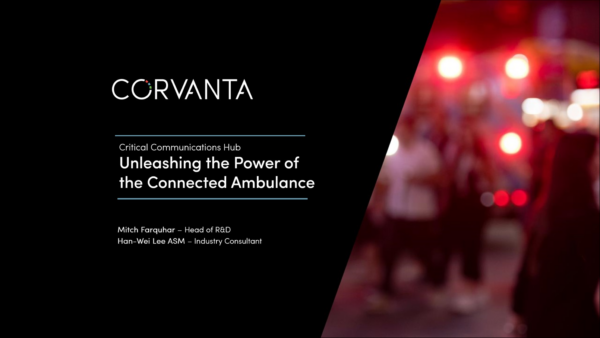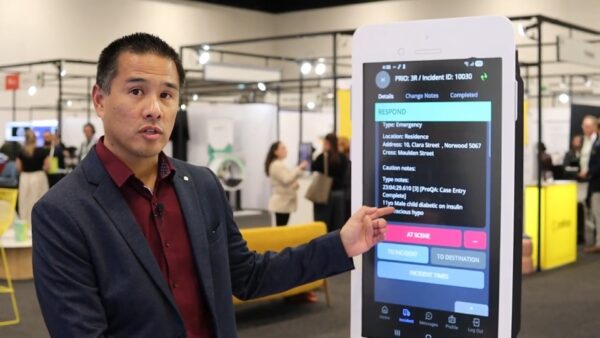Reliable and uninterrupted communication is paramount for ambulance service providers. They require robust connectivity to ensure effective communication, seamless mapping to patients, and duress alerts. To meet these demands, implementing multiple redundancy communication safeguards in ambulances is essential.


Mitch Farquhar
R&D Manager
Mitch has more than 20 years of experience building software solutions. He has led teams through all phases of the software development life cycle, including prototyping, patenting, commercialisation, implementation, and maintenance. Mitch plays a key role in defining Corvanta’s strategy for the provision of next generation pre-hospital care technology to our customers.
What is a Multi-Bearer Network?
Many networks are operating in Australia at any given time. In our homes, we typically choose between NBN or the older ADSL networks to connect all our devices to the Internet or even 5G. For ambulances, there is more choice and more robust needs.
First, there are the cellular networks from the different telco providers. Each of these has 5G and 4G offerings. Then, in some states, ambulances can connect to government-operated digital radio networks such as the Qld GRN, NSW PSN and now the Tas GRN in Tasmania.
The latest entrants into mobile networks for vehicles are the Low Earth Orbiting (LEO) satellite providers. These include Starlink and the upcoming OneWeb networks.
Emergency Services require devices that support multi-bearer networks that can connect to more than one of these networks simultaneously. These devices then make a smart choice when sending data and use the most reliable network available. With a vehicle moving location frequently, the most reliable network will always vary considerably. Multi-bearer support ensures continuous connection, duress awareness and seamless communication.
Uninterrupted Communication
Ambulance crews rely heavily on communication systems to exchange vital information with dispatch centres, hospitals, and other emergency responders. However, placing exclusive reliance on a single network entails substantial risks. Failures resulting from network congestion, black spots, remoteness or unforeseen technical failures may occur, leading to communication breakdowns. By employing a multi-bearer network, emergency ambulances remain connected. This redundancy ensures uninterrupted communication, even in the most challenging environments, and minimises the risk of transmission failure, increased paramedic or patient risks or delay in vital information sharing, such as scene safety and clinical conditions or deterioration of the patient.
Duress Alert Capability
The safety of clinicians is paramount. In high-risk situations or when confronted with real or potential threats, ambulance personnel need to know their duress alert will reach the dispatch centre to receive the help they need – a multi-bearer network equips ambulances with the capability to transmit duress alerts using different communication channels.
This redundancy increases the likelihood of alerts being successfully transmitted. For example, we know that 1 in 10 duress messages is transmitted through a secondary network on our critical communications hub, enhancing the safety net for ambulance crews.

Enhanced Coverage and Reach
Ambulances operate in diverse urban, rural and remote environments, from snowcapped mountains to the heat of a Queensland Summer, and remote NSW to the wilds of Tasmania, where network coverage may vary.
A multi-bearer network combines the strengths of different communication technologies, such as multiple cellular networks, satellite communications, and dedicated public safety networks. By leveraging these multiple bearers, ambulances ensure access to broader coverage and connectivity in remote areas or areas with weak network signals or nothing but satellite coverage. This expanded reach is crucial for maintaining continuous communication, regardless of the ambulance’s location and ensuring operator safety.
Future-Proofing and Adaptability
Technology is constantly evolving, and new communication technologies and standards continue to emerge. By adopting a multi-bearer network approach, ambulance services can future-proof their communication infrastructure. They can easily integrate new technologies and adapt to advancements in the communication landscape without major overhauls or disruptions. This adaptability ensures that ambulance services remain at the forefront of reliable and efficient communication, evolving with the communities’ changing healthcare needs.
An example of approaching technology is a recent announcement by Toyota of electric vehicles with a 1200 km range. This range will allow ambulances to cover a much larger area and venture into more remote locations. Such locations are unlikely to be serviced equally by the same network, making a multi-bearer approach necessary for continuous, uninterrupted communication.
Conclusion
A multi-bearer network in ambulances provides the necessary foundation for critical communications, duress alerts, and enhanced safety for first responders. By leveraging multiple communication technologies, these networks offer uninterrupted connectivity, wider coverage, load balancing, and adaptability. As technology continues to evolve, it becomes paramount for ambulance services to prioritise the adoption of critical comms hubs with multi-bearer networks. This ensures that the vital communication infrastructure remains up-to-date, capable of meeting the ever-growing demands of out-of-hospital care, and ultimately making a greater impact in improving paramedic safety and patient outcomes.

Mitch Farquhar
R&D Manager
Mitch has more than 20 years of experience building software solutions. He has led teams through all phases of the software development life cycle, including prototyping, patenting, commercialisation, implementation, and maintenance. Mitch plays a key role in defining Corvanta’s strategy for the provision of next generation pre-hospital care technology to our customers.
READ MORE
CRITICAL COMMS HUB SERIES

Critical Comms Hub Series: Enhancing First Responder Safety through AI Fatigue Detection
First responders often work under high-pressure and demanding conditions, which can lead to fatigue. Fatigue significantly impacts safety and the

Critical Comms Hub Series: When Your Communications Can’t Be Compromised
Reliable and uninterrupted communication is paramount for ambulance service providers. They require robust connectivity to ensure effective communication, seamless mapping

Critical Comms Hub Series: Unleashing the Power of the Connected Ambulance
Comms Hubs? MDTs? Apps? What’s the difference? Join Corvanta’s Head of Research & Development, Mitch Farquhar, and Industry

Critical Comms Hub Series: Harnessing V2X Technology in Ambulance Services
Lights and sirens are no longer the only way to alert traffic to an approaching ambulance. Vehicle-to-everything (V2X) communication allows



